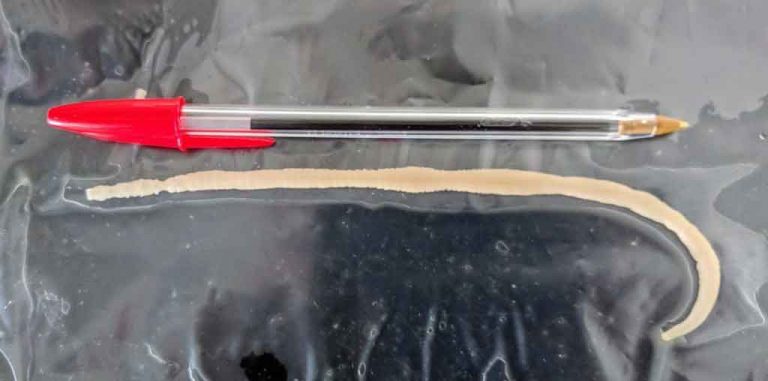Every day, we have multiple discussions with clients as to why (and how) they should worm their pets on a regular basis. I was reminded of this yesterday when a client came in to show us what his cat had just vomited up – a 10 inch long tapeworm! Sorry if the accompanying photo is a bit graphic but that’s what tapeworms look like.
The cat in question is an incorrigible hunter. According to his owner, he spends hours, every day, out looking for prey. He was well fed at home and seemed to be very successful at bringing home a regular stream of ‘snacks’. However, the cat seemed a bit scraggy-looking and was always hungry. It came as no real surprise to us that he threw up a healthy happy tapeworm! Of course, instead of feeding himself, the cat had been feeding the tapeworm. No wonder he was hungry!
With this in mind, I thought I should provide a few tips regarding intestinal worm control in pets.
Intestinal worms are really common!
- If left to their own devices, most, if not all, pets would have a worm burden – they’re a fact of life
- Parasites can be passed from the mother to pups and kittens so they start very early.
- If you stop treating, they come back!
- With heavy infestations, you’ll often see a little white tapeworm segment under your cat’s tail or long thin spaghetti-like roundworms in faeces (yuck!)
- In really heavy infestations, we can see pets vomiting up worms
They’re easily transmitted to other pets and cause significant damage
- Most intestinal parasites are shed in faeces and transmitted to other pets this way (licking).
- If one of your pets has worms, chances are that so do the others
- Worms deprive their hosts of vital nutrients and energy
- They can also migrate into other parts of the body such as liver and lungs. As you can imagine, this isn’t good for health!
There are two main types of tapeworm – one passed on by eating prey, the other through fleas
- If your cat (or dog) is a hunter or scavenger, you should be worming them every month
- Regular and effective flea control is important in disrupting the tapeworm lifecycle. Don’t rely on supermarket products for this – they don’t work very well!
Some intestinal worms can affect people, particularly children
- What we call ‘larval migrans’
- Worms burrow under the skin and potentially into eyes – not nice!
- If you have young children around the house, you should be doubly vigilant with your worming program.
They’re easy to prevent!
- For most dogs and cats, we can use quarterly tables to remove any current worm burden
- For ‘hunters’ this should be done monthly
- ‘Advocate’ will cover most intestinal worms, as well as fleas, but not tapeworm – great for those ‘stay-at-home’ cats (and dogs)
I should point out that not all pets have intestinal parasites. On the other hand, they’re a common problem and a significant health risk to both pet and owner. As such, we’d strongly advise that you maintain a regular worming program for all your pets. The preventive treatment is pretty easy and very affordable. For more information, give us a call on 8522 3500. Otherwise, just come in and buy the medication from our fantastic receptionists. They’ll let you know what’s best for your situation.
If any of these stories that we publish are of interest to you and if you like our service, we’d encourage you to review us either by adding a comment to the blog, by visiting our FaceBook page or by reviewing us on Google. We rely heavily on word of mouth for our new clients and your (positive, hopefully!) recommendations are hugely helpful!






